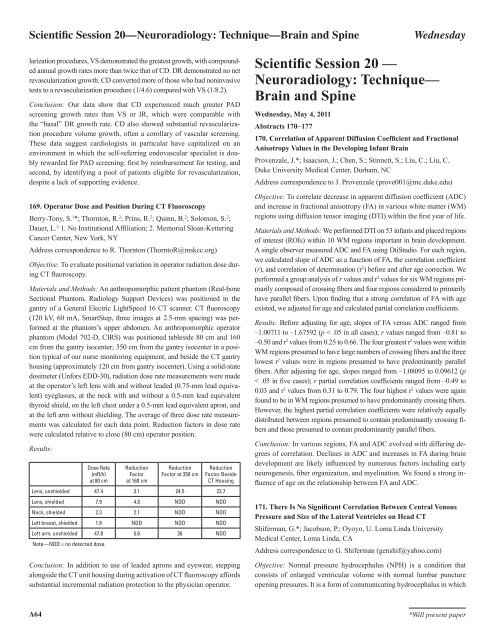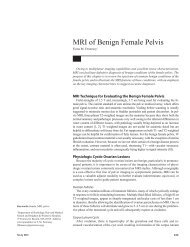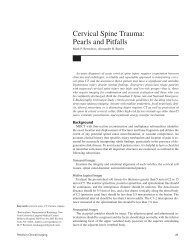<strong>Scientific</strong> <strong>Session</strong> 20—Neuroradiology: Technique—Brain and SpineWednesdaylarization procedures, VS demonstrated the greatest growth, with compoundedannual growth rates more than twice that of CD. DR demonstrated no netrevascularization growth. CD converted more of those who had noninvasivetests to a revascularization procedure (1/4.6) compared with VS (1/8.2).Conclusion: Our data show that CD experienced much greater PADscreening growth rates than VS or IR, which were comparable withthe “basal” DR growth rate. CD also showed substantial revascularizationprocedure volume growth, often a corollary of vascular screening.These data suggest cardiologists in particular have capitalized on anenvironment in which the self-referring endovascular specialist is doublyrewarded for PAD screening: first by reimbursement for testing, andsecond, by identifying a pool of patients eligible for revascularization,despite a lack of supporting evidence.169. Operator Dose and Position During CT FluoroscopyBerry-Tony, S. 1 *; Thornton, R. 2 ; Prins, R. 2 ; Quinn, B. 2 ; Solomon, S. 2 ;Dauer, L. 2 1. No Institutional Affiliation; 2. Memorial Sloan-KetteringCancer Center, New York, NYAddress correspondence to R. Thornton (ThorntoR@mskcc.org)Objective: To evaluate positional variation in operator radiation dose duringCT fluoroscopy.Materials and Methods: An anthropomorphic patient phantom (Real-boneSectional Phantom, Radiology Support Devices) was positioned in thegantry of a General Electric LightSpeed 16 CT scanner. CT fluoroscopy(120 kV, 60 mA, SmartStep, three images at 2.5-mm spacing) was performedat the phantom’s upper abdomen. An anthropomorphic operatorphantom (Model 702-D, CIRS) was positioned tableside 80 cm and 160cm from the gantry isocenter; 350 cm from the gantry isocenter in a positiontypical of our nurse monitoring equipment; and beside the CT gantryhousing (approximately 120 cm from gantry isocenter). Using a solid-statedosimeter (Unfors EDD-30), radiation dose rate measurements were madeat the operator’s left lens with and without leaded (0.75-mm lead equivalent)eyeglasses, at the neck with and without a 0.5-mm lead equivalentthyroid shield, on the left chest under a 0.5-mm lead equivalent apron, andat the left arm without shielding. The average of three dose rate measurementswas calculated for each data point. Reduction factors in dose ratewere calculated relative to close (80 cm) operator position.Results:Dose Rate(mR/h)at 80 cmReductionFactorat 160 cmReductionFactor at 350 cmReductionFactor BesideCT HousingLens, unshielded 47.4 3.1 24.5 23.7Lens, shielded 7.9 4.8 NDD NDDNeck, shielded 2.3 2.1 NDD NDDLeft breast, shielded 1.8 NDD NDD NDDLeft arm, unshielded 47.8 5.6 26 NDDNote—NDD = no detected dose.Conclusion: In addition to use of leaded aprons and eyewear, steppingalongside the CT unit housing during activation of CT fluoroscopy affordssubstantial incremental radiation protection to the physician operator.<strong>Scientific</strong> <strong>Session</strong> 20 —Neuroradiology: Technique—Brain and SpineWednesday, May 4, 2011Abstracts 170-177170. Correlation of Apparent Diffusion Coefficient and FractionalAnisotropy Values in the Developing Infant BrainProvenzale, J.*; Isaacson, J.; Chen, S.; Stinnett, S.; Liu, C.; Liu, C.Duke University Medical Center, Durham, NCAddress correspondence to J. Provenzale (prove001@mc.duke.edu)Objective: To correlate decrease in apparent diffusion coefficient (ADC)and increase in fractional anisotropy (FA) in various white matter (WM)regions using diffusion tensor imaging (DTI) within the first year of life.Materials and Methods: We performed DTI on 53 infants and placed regionsof interest (ROIs) within 10 WM regions important in brain development.A single observer measured ADC and FA using DtiStudio. For each region,we calculated slope of ADC as a function of FA, the correlation coefficient(r), and correlation of determination (r 2 ) before and after age correction. Weperformed a group analysis of r values and r 2 values for six WM regions primarilycomposed of crossing fibers and four regions considered to primarilyhave parallel fibers. Upon finding that a strong correlation of FA with ageexisted, we adjusted for age and calculated partial correlation coefficients.Results: Before adjusting for age, slopes of FA versus ADC ranged from–1.00711 to –1.67592 (p < .05 in all cases); r values ranged from –0.81 to–0.50 and r 2 values from 0.25 to 0.66. The four greatest r 2 values were withinWM regions presumed to have large numbers of crossing fibers and the threelowest r 2 values were in regions presumed to have predominantly parallelfibers. After adjusting for age, slopes ranged from –1.08095 to 0.09612 (p< .05 in five cases); r partial correlation coefficients ranged from –0.49 to0.03 and r 2 values from 0.31 to 0.79. The four highest r 2 values were againfound to be in WM regions presumed to have predominantly crossing fibers.However, the highest partial correlation coefficients were relatively equallydistributed between regions presumed to contain predominantly crossing fibersand those presumed to contain predominantly parallel fibers.Conclusion: In various regions, FA and ADC evolved with differing degreesof correlation. Declines in ADC and increases in FA during braindevelopment are likely influenced by numerous factors including earlyneurogenesis, fiber organization, and myelination. We found a strong influenceof age on the relationship between FA and ADC.171. There Is No Significant Correlation Between Central VenousPressure and Size of the Lateral Ventricles on Head CTShiferman, G.*; Jacobson, P.; Oyoyo, U. Loma Linda UniversityMedical Center, Loma Linda, CAAddress correspondence to G. Shiferman (genshif@yahoo.com)Objective: Normal pressure hydrocephalus (NPH) is a condition thatconsists of enlarged ventricular volume with normal lumbar punctureopening pressures. It is a form of communicating hydrocephalus in whichA64*Will present paper
Wednesday<strong>Scientific</strong> <strong>Session</strong> 20—Neuroradiology: Technique—Brain and Spinethere is no structural blockage of cerebrospinal fluid flow. NPH is knownfor the common clinical association of gait disturbance, urinary incontinence,and dementia. In some cases, NPH is reversible by the placementof a ventriculoperitoneal shunt. However, diagnosing idiopathic NPH isdifficult and identifying those patients who will be more likely to respondto shunt therapy is harder still. The specific purpose of this study is to seeif there is a correlation between central venous pressure (CVP) and sizeof the lateral ventricles. If one exists, this knowledge may one day aid inthe diagnosis and stratification of patients with idiopathic NPH.Materials and Methods: After obtaining institutional review board approval,all CVP measurements available in the Loma Linda MedicalCenter electronic health record dating back to 2007 were retrospectivelycollected. A retrospective cohort of 77 patients was then selected fromthis data that had both documented CVP measurements and CT scansof the head. Inclusion criteria were age greater than 15 years, admissionafter 2007, available CT of the head, and available CVP measurementwithin 6 weeks of head CT. Exclusion criteria were any acute intracranialabnormality on CT, large nonlacunar infarct on CT, prior history ofbrain surgery, and Alzheimer’s dementia. The patient cohort includedboth male and female patients. The ages ranged from 16 to 93 years witha mean age of 63 years. Size of the lateral ventricles was measured bydividing the maximal diameter of the frontal horns of the lateral ventricleson head CT (at the slice where the frontal horns are largest) by themaximum width of the cranial cavity measured at the inner tables of theskull at the same level. Spearman’s correlation coefficient was used to determinethe overall correlation between CVP and lateral ventricular size.Results: Spearman’s correlation coefficient for CVP and lateral ventricularsize was 0.021 with a p value of 0.855 for the entire cohort. For malepatients, Spearman’s correlation coefficient was –0.022 with a p valueof 0.883. For female patients, Spearman’s correlation coefficient was–0.022 with a p value of 0.883.Conclusion: There is no significant correlation between CVP and size ofthe lateral ventricles on head CT.172. Diffusion Tensor <strong>Imaging</strong> of the Corpus Callosum inMultiple Sclerosis Patients: Differences Between Enhancing andNonenhancing CohortsSrinivasan, A. 1 *; Mohan, S. 1 ; Lee, Y. 2 ; Berini, S. 1 ; Braley, T. 1 ; Irani, D. 1 ;Segal, B. 1 1. University of Michigan Health System, Ann Arbor, MI; 2.Korea University Medical College, Seoul, South KoreaAddress correspondence to A. Srinivasan (ashoks@med.umich.edu)Objective: To analyze the differences in diffusion tensor imaging (DTI)–derived metrics of the corpus callosum in relapsing remitting and secondaryprogressive multiple sclerosis patients with enhancing and nonenhancinglesions.Materials and Methods: The study was approved by the institutionalreview board. DTI images of 32 patients with relapsing remitting MS(RRMS) and 14 patients with secondary progressive MS (SPMS) wereretrospectively analyzed on a General Electric Advantage workstation togenerate fractional anisotropy (FA) and mean diffusivity (MD) maps. FAand MD values were calculated by freehand regions of interest at the levelof genu, midbody, and splenium of corpus callosum by two neuroradiologistswho were blinded to clinical information. The conventional imageswere also reviewed to enable generation of four groups: I, RRMS with nolesion enhancement; II, RRMS with enhancing lesions; III, SPMS with nolesion enhancement; and IV, SPMS with enhancing lesions. Differences inFA and MD between groups I and II and between groups III and IV werestudied using the unequal variance independent samples t test. Differenceswere evaluated in all three regions of the corpus callosum.Results: Significant differences were seen in mean FA values in all threeregions of the corpus callosum (ML) between groups III and IV by readerI (p = 0.004, 0.01 and 0.005 for genu, body, and splenium) and in thegenu and splenium of ML by reader II (p = 0.04 and 0.001, respectively).All three regions of the ML demonstrated lower FA values in group IV(enhancing SPMS) compared with group III. No significant differencesin MD values were seen between groups III and IV in all ML regions byboth readers. Also, none of the regions in the ML showed significant differencesin MD and FA values between groups I and II (for both readers).Conclusion: Fractional anisotropy of SPMS patients with enhancing lesionsappears to be significantly lower than that seen in SPMS patientswith no actively enhancing foci, suggesting that there may be more whitematter damage in the former. Hence, we may be able to use FA as amarker for disease activity and possibly for follow-up.173. Association Between Carotid Artery Plaque Inflammation andBrain MRISaba, L.*; Lai, L.; Sanfilippo, R.; Faa, G.; Montisci, R.; Bura, R.;Anzidei, M.; Mallarini, G. A.O.U, Cagliari Sardegna, ItalyAddress correspondence to L. Saba (lucasaba@tiscali.it)Objective: There is evidence that carotid plaque composition is an independentrisk factor of ischemic stroke. The purpose of this work was toexplore the association between the entity of inflammatory cells presentin the carotid plaques and brain MRI findings.Materials and Methods: Twenty-one consecutive patients (16 men, 5women; median age, 64 years) were prospectively analyzed. Brain MRIwas performed using a 1.5-T system and lesions pertinence of the anteriorcirculation were recorded. All patients underwent carotid endarterectomyen bloc” histological sections were prepared and immunohistochemicalstudy was used to characterize and quantify the inflammatorycells present in plaques, using the CD68 and CD3 monoclonal antibodies.Cell counting was performed at a magnification of ×400 using a test gridwith an area of 0.25 mm 2 .Results: The immunohistochemical study demonstrated that the cap ofruptured plaques in patients affected by stroke or transient ischemic attack(n = 15) was characterized by many inflammatory cells, principallymonocytes and macrophages (CD68) and T lymphocytes (CD3) comparedwith those cells observed in ruptured plaques from patients withwithout symptoms (p = 0.004). Linear regression analysis demonstratedan association between the number of brain infarcts (lacunar and nonlacunar)and the entity of inflammatory cells (p = 0.003).Conclusion: Results of this preliminary study suggest that the entity ofinflammatory cells in the carotid artery plaque is associated with the presenceof cerebrovascular events and with the number of MRI brain detectableinfarct.*Will present paperA65
















